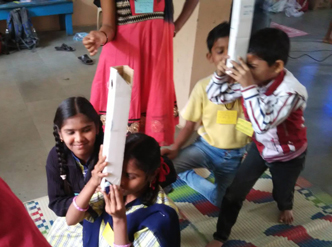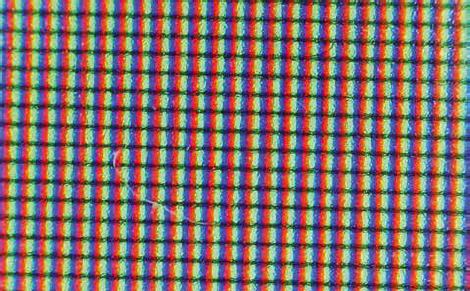Supporting materials
Supporting material (Word file)
Supporting material (Pdf file)
Download
Download this article as a PDF

School children in India built their own digital microscope, bent light and investigated gas laws. Find out how.
In India, as in many countries, the main focus in science classrooms is on exams rather than musing on the fascinating concepts and understanding of the world that science offers. This can mean that students lose interest in studying science – a problem that is further hampered where there is a lack of facilities, expertise or mentors. We started the ‘Science is fun’ outreach programme to address these problems. The 15-person team, led by undergraduate and research scientists, conducted four workshops with underprivileged children in Indian primary and secondary schools during December 2014 and January 2015.

The workshops explored basic science concepts, reinforced by hands-on experiments using readily available materials. They were generally successful, with students keen to participate and motivated to learn more after the workshops. We were also pleasantly surprised to see students engaging with new concepts and not hesitating to participate in the discussions. We tried to ensure teachers were central to the activities, and also designed the experiments to be easily repeatable so that teachers could incorporate them into their own lessons once the workshops were over.
In this article, we describe three of our successful activities: building a periscope and a digital microscope, and two experiments based on the physical gas laws. All are cheap and easy to perform, yet reveal interesting scientific principles. Each activity takes about an hour.
Periscopes allow us to look over or around obstacles without being in the line of sight, and they are still used today in submarines. The most basic version involves two plane mirrors, one placed at each end of a long tube, with the mirrors parallel to each other and at 45° to the length of the tube.
This simple periscope is easy to build in around one hour and requires no more materials than cardboard, mirrors, scissors and sticky tape. It can be used with younger children who can safely handle scissors and mirrors (e.g. 8–13), as a fun activity and an introduction to the reflection of light. Older students (e.g. 14–16) could use it to learn about the reflection of plane mirrors. Figure 1 shows how the periscope is made and full assembly instructions can be downloaded from the additional materials section.

Although the basic design of the periscope is simple and straightforward, it demonstrates the law of reflection: the angle of incidence of a light ray is equal to its angle of reflection (figure 2). Since the angles of incidence and reflection are the same, light that is travelling horizontally to hit a mirror orientated at 45º will then travel vertically. By adding another mirror angled at 45º, the light path is re-orientated to travel horizontally again, but now it is displaced from the original beam path by the height of the periscope.

By building their own periscope, students can see for themselves that light travels in straight lines and that the direction of travel can be altered by reflective surfaces: a common use of periscopes in optics is to change the height of a light path. This activity can be extended to be more challenging for older students by requiring a different angle of observationw1.
Suitable questions for your students could include:
Microscopes allow us to explore details that are too small to be seen by the naked eye, but they are usually expensive. Here, we show how to build a cheap webcam-based microscope, so that students can learn the basics of optics and image formation while exploring the microscopic world around us.

The microscope consists of a plastic tube with a lens attached to one end and a webcam to the other, attached to a computer. The microscope is supported by a clamp stand, the sample to be viewed is clamped in place below the lens, and a torch is shone onto or through the sample. The image is focused by the lens onto the image sensor of the webcam and thus passed to the computer for analysis. By adjusting the length of the tube or the relative positions of the microscope and sample, the image can be zoomed and focused. Figure 3 gives an overview of the construction, and full instructions for building and adjusting the microscope can be downloaded from the additional materials section.
The key difference between a digital microscope and a standard (analogue) school microscope is that students can take digital pictures that can be stored and analysed in later lessons. They can also easily make quantitative measurements using appropriate software. Furthermore, if resources are limited, the output from a single digital microscope can be projected onto a screen for the whole class to see. Finally, the digital microscope can be used to make videos, allowing a unique view into the lives of plants and animals.
Constructing the microscope takes around one hour and can be done by students aged 14 years and over, perhaps in a small group. Allow another hour for using the microscope, an activity that is suitable for students of all ages.
To start with, you could ask your students to examine the following samples under the microscope:
Using image software (e.g. the free software ImageJw2), they could then use quantitative measurements to make some forensic investigations, such as:

The digital microscope could also be used to quantify variability in microscopic samples. For example, your students could take 50 images of hair and measure the widths to find the mean and standard deviation of the hair width. Do they differ between hair colours? Between animal species? Such investigations are much more difficult to do with an analogue microscope.
By making movies with their digital microscope, your students could record the tracks of pond animals and compare the patterns of movement of different species. Over a longer period of time, they could even watch plants grow. For example, they could leave a plant root under the microscope for a week and get the computer to record an image every hour. Using the resulting movie, they could then plot a growth curve.

We all enjoy playing with balloons or watching hot-air balloons, but these activities are rarely related to the gas laws learned in the classroom. We therefore developed an experiment to show the relationship between the temperature and volume of a gas. This relationship is described by Charles’ law, which states that, for a fixed amount of gas at constant pressure, the volume of the gas is directly proportional to its temperature.
This experiment takes around one hour and is suitable for students from around 14 years old. For older students, the activity can be adapted to experimentally estimate absolute zero.
Care must be taken when using hot water. See also the general Science in School safety note.
This simple set-up maintains a fixed amount of gas (the contents of the bottle) at a fixed pressure (atmospheric). Once the bottle is placed in hot water, the temperature of the gas inside it increases and the gas expands – as described by Charles’ law – and it begins to fill the balloon, as students will see (figure 4). Meanwhile, the volume of the balloon at the room temperature should remain the same.
This process is reversible. Remove the bottle from the hot water and place it in the water at room temperature: the balloon will slowly shrink again.
Another simple demonstration of Charles’ law is to inflate a balloon, then place it in a freezer for about an hour and observe the change in volume. We also used balloons to demonstrate Boyle’s law (see the additional materials section) – which states that at a constant temperature, the pressure of a fixed amount of gas changes inversely with its volume.
For older students (ages 16–19), absolute temperature can be roughly estimated by measuring the gas volume of a frictionless syringe at different temperatures.

You should find a linear relationship between temperature and volume. By extrapolating to zero volume, the corresponding temperature on the x axis can be seen to be approximately 270 °C (the actual value of absolute zero is -273.15 °C)w3.
Supporting material (Word file)
Supporting material (Pdf file)
Download this article as a PDF